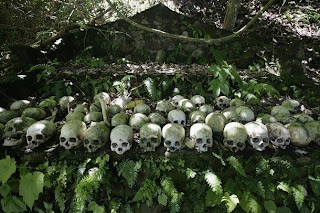The mountain village of Trunyan is located at the foot of
As the term "Bali Aga has acquired a negative connotation, the term Bali Mula, or 'original Balinese', is often used instead. However, the Bali Aga are in no sense 'original', while the term 'Mountain Balinese' is, from a historical perspective, completely apposite. The Bali Aga namely have always occupied their ancestral villages from choice, and performed their traditional crafts and trades appropriate to the nature of the land.
According to copper plate inscriptions in one of the shrines, the main temple of the village dates back to the 10th century AD (833 Çaka), although the village itself is believed to be much older than the temple.
Trunyanese society has two 'castes', the banjar jero and the banjar jaba. These castes are not based on the Hindu ideas of purity, but are instead determined by descent during the period of the Gelgel dynasty. This caste system is an important example of when outside influence actually did affect the life of the Trunyanese people, for those belonging to the banjar jero are the descendants of rulers, id est the Trunyanese who were appointed by the kings of Gelgel to rule, and those of the banjar jaba are the descendants of the people, id est those who were ruled by the banjar jero.
Another example of outside influence is the requirement for their young men to travel through lowland
Prestige consciousness, which is so dominantly present everywhere in
 Funeral rites of Trunyan - Contrary to elswhere in Hindu Bali the Trunyanese do not cremate their dead. Instead, after a ritual cleansing with rain water, the body of the deceased is placed in a bamboo cage under the taru menyan tree until the forces of nature, in particular the wind, has dissolved the body tissues and only the skeleton remains. Then the skull is placed on a stairs-shaped stone altar which is located some 500 meter north of the banjar
Funeral rites of Trunyan - Contrary to elswhere in Hindu Bali the Trunyanese do not cremate their dead. Instead, after a ritual cleansing with rain water, the body of the deceased is placed in a bamboo cage under the taru menyan tree until the forces of nature, in particular the wind, has dissolved the body tissues and only the skeleton remains. Then the skull is placed on a stairs-shaped stone altar which is located some 500 meter north of the banjar
This ancient practice is a reminicsent of the neolithic Agama Bayu sekt, one of the six most important religious-spiritual sekts that dominated
Taru Menyan translates as 'nice smelling tree'. The typical scent this tree eminates, neutralizes the smell of rotting bodies. It is also this tree from which the name Trunyan is derived.
Furthermore typical for the funeral rites of Trunyan is that only the bodies of married people are placed in bamboo cages; if the deceased is unmarried, the body is normally buried at the cemetry.
Also typical is that women are not allowed to attend the Pengiriman ceremonies, the bringing of the body to the taru menyan tree or to the cemetry. The reason for this is the belief that otherwise the village will be struck by disaster, such as an earthquake, a volcanic eruption, or a land slide. How and when this rule came into being however is not clear.










No comments:
Post a Comment